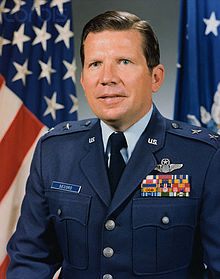
The Distinguished Flying Cross (DFC) is a military decoration of the United States Armed Forces. The medal was established on July 2, 1926, and is currently awarded to any persons who, after April 6, 1917, distinguish themselves by single acts of heroism or extraordinary achievement while participating in aerial flight. Both heroism and extraordinary achievement are entirely distinctive, involving operations that are not routine. The medal may be awarded to friendly foreign military members in ranks equivalent to U.S. Pay Grade of O-6 and below, in actual combat in support operations.
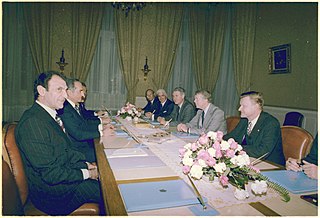
William Healy Sullivan was an American Foreign Service career officer who served as ambassador to Laos from 1964 to 1969, the Philippines from 1973 to 1977, and Iran from 1977 to 1979.
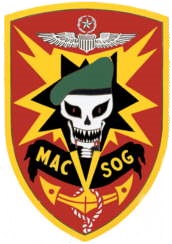
Military Assistance Command, Vietnam – Studies and Observations Group (MACV-SOG) was a highly classified, multi-service United States special operations unit which conducted covert unconventional warfare operations before and during the Vietnam War.
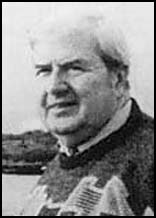
Thomas Gregory Clines was a Central Intelligence Agency covert operations officer who was a prominent figure in the Iran-Contra Affair.
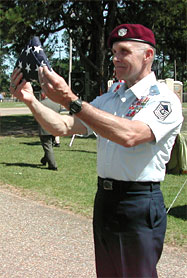
Chief Master Sergeant Wayne Fisk is a retired United States Air Force pararescueman. He was involved in Operation Ivory Coast, the raid on the Son Tay prisoner of war camp, and later the rescue of the crew of the SS Mayagüez. When the Mayagüez was hijacked by Cambodian Communist forces in May 1975, Fisk was a member of the assault force that successfully recovered the ship and the entrapped United States Marines. For his actions, he was awarded his second Silver Star.

The Intelligence Star is an award given by the Central Intelligence Agency to its officers for "voluntary acts of courage performed under hazardous conditions or for outstanding achievements or services rendered with distinction under conditions of grave risk". The award citation is from the Director of the Central Intelligence Agency and specifically cites actions of "extraordinary heroism". It is the third-highest award given by the Central Intelligence Agency, behind the Distinguished Intelligence Cross and Distinguished Intelligence Medal, and is analogous to the Silver Star, the US military award for extraordinary heroism in combat. Only a few dozen people have received this award, making it one of the rarest valor awards awarded by the US government.
The United States Air Force (USAF) deployed combat aircraft to Thailand from 1960 to 1975 during the Vietnam War. Today, US military units train with other Asian militaries in Thailand. Royal Thai Air Force Bases are an important element in the Pentagon's "forward positioning" strategy.
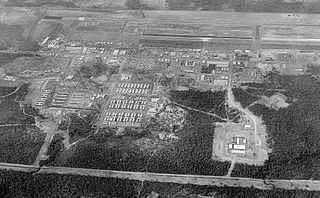
The Nakhon Phanom Royal Thai Navy Base (NKP), formerly Nakhon Phanom Royal Thai Air Force Base, is a Royal Thai Navy facility used for riverine patrols along the Mekong River. It is approximately 587 km (365 mi) northeast of Bangkok, 14.5 km (9.0 mi) west of Nakhon Phanom city in Nakhon Phanom Province in the northeastern region of Thailand, and 411 km (255 mi) from Hanoi in Vietnam. The Mekong River is NKP's border with Laos. The airfield at NKP is jointly used as a civilian airport.
Ubon Royal Thai Air Force Base is a Royal Thai Air Force (RTAF) facility located near the city of Ubon Ratchathani, in Ubon Ratchathani Province. It is approximately 488 km northeast of Bangkok. The Laos border is about 60 kilometres (37 mi) directly east. The facility is also used as a civil airport.
Udorn Royal Thai Air Force Base is a Royal Thai Air Force (RTAF) base, the home of 23rd Wing Air Command. It is in the city of Udon Thani in northeastern Thailand and is the main airport serving the city and province.

The Battle of Lima Site 85, also called Battle of Phou Pha Thi, was fought as part of a military campaign waged during the Vietnam War and Laotian Civil War by the North Vietnamese People's Army of Vietnam (PAVN) and the Pathet Lao, against airmen of the United States Air Force (USAF)'s 1st Combat Evaluation Group, elements of the Royal Lao Army, Royal Thai Border Patrol Police, and the Central Intelligence Agency-led Hmong Clandestine Army. The battle was fought on Phou Pha Thi mountain in Houaphanh Province, Laos, on 10 March 1968, and derives its name from the mountaintop where it was fought or from the designation of a 700 feet (210 m) landing strip in the valley below, and was the largest single ground combat loss of United States Air Force members during the Vietnam War.

Operation Barrel Roll was a covert U.S. Air Force 2nd Air Division and U.S. Navy Task Force 77, interdiction and close air support campaign conducted in the Kingdom of Laos between 14 December 1964 and 29 March 1973 concurrent with the Vietnam War. The operation resulted in 260 million bombs being dropped on Laos, making Laos "the most heavily bombed nation in history".
CIA activities in Laos started in the 1950s. In 1959, U.S. Special Operations Forces began to train some Laotian soldiers in unconventional warfare techniques as early as the fall of 1959 under the code name "Erawan". Under this code name, General Vang Pao, who served the royal Lao family, recruited and trained his Hmong and Iu-Mien soldiers. The Hmong and Iu-Mien were targeted as allies after President John F. Kennedy, who refused to send more American soldiers to battle in Southeast Asia, took office. Instead, he called the CIA to use its tribal forces in Laos and "make every possible effort to launch guerrilla operations in North Vietnam with its Asian recruits." General Vang Pao then recruited and trained his Hmong soldiers to ally with the CIA and fight against North Vietnam. The CIA itself claims that the CIA air operations in Laos from 1955-1974 were the "largest paramilitary operations ever undertaken by the CIA."
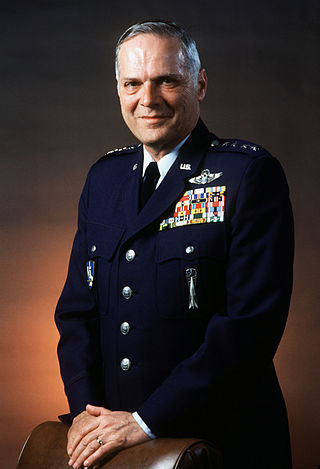
Charles Lawthers Donnelly Jr. was a general in the United States Air Force who served as Commander in Chief, United States Air Forces in Europe/Commander, Allied Air Forces Central Europe from 1984 to 1987. Donnelly was also a fighter pilot in the Vietnam War. He died of cancer in Malcolm Grow Medical Center at Andrews Air Force Base on July 3, 1994, at the age of 64.

Forward air controllers (FACs) played a significant part in the Vietnam War from the very start. Largely relegated to airborne duty by the constraints of jungled terrain, FACs began operations as early as 1962. Using makeshift propeller-driven aircraft and inadequate radio nets, they became so essential to air operations that the overall need for FACs would not be completely satisfied until 1969. The FAC's expertise as an air strike controller also made him an intelligence source, munitions expert, communication specialist, and above all, the on-scene commander of the strike forces and the start of any subsequent combat search and rescue if necessary.
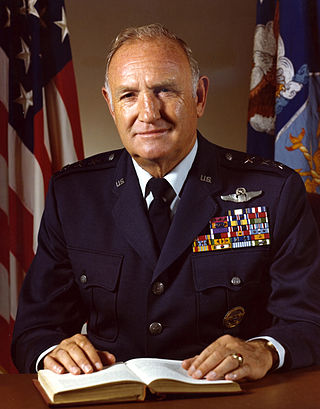
Carroll Devol "Rock" Brett was a lieutenant general in the United States Air Force (USAF) who piloted aircraft during crises and wars from 1948 through the Vietnam War (1960s). He served in Austria, West Germany, South Korea, South Vietnam, the United Kingdom, Iran and Turkey, before his final assignment as commander of Allied Air Forces Southern Europe in 1977. After his retirement in 1978, he was a defense consultant for more than 20 years, retiring in 1998.

Lima Site 85 was a clandestine military installation in the Royal Kingdom of Laos guarded by the Hmong "Secret Army", the Central Intelligence Agency, and the United States Air Force used for Vietnam War covert operations against communist targets in ostensibly neutral Laos under attack by the Vietnam People's Army. Initially created for a CIA command post to support a local stronghold, the site was expanded with a 1966 TACAN area excavated on the mountaintop where a 1967 command guidance radar was added for Commando Club bombing of northern areas of North Vietnam. The site ended operations with the Battle of Lima Site 85 when most of the U.S. technicians on the mountaintop were killed, including CMSgt Richard Etchberger. For his heroism and sacrifice, Etchberger received the Air Force Cross posthumously. The operation remained classified, however, and the existence of the award was not publicly acknowledged until 1998. After the declassification of LS 85 and a reevaluation of his actions, Etchberger was awarded the Medal of Honor in 2010.
The raid onBan Naden of 9 January 1967 was a successful rescue of prisoners of war during the Vietnam War. The raid was improvised after local Central Intelligence Agency officers induced a Pathet Lao deserter to lead a rescue party back to the prison camp. At about 0400 hours on 9 January 1967, a raiding party of 10 Lao mercenaries led by Sergeant Te killed or dispersed the communist guard force, only to discover twice as many rescuees as they had counted upon. Some of the captives immediately returned to their local homes, while the others followed their rescuers to an impromptu pickup zone in the midst of the Ho Chi Minh Trail. Hastily summoned Air America helicopters retrieved the raiders and the remaining prisoners, one of whom was Phisit Intharathat.
Charles Larimore Jones, also known as Charlie Jones, was an architect of the U.S. Air Force's forward air control doctrine, as well as one of its early practitioners during the Laotian Civil War. He was trained in forward air control techniques as a Combat Controller in 1954. In 1962, he was one of the Operation Jungle Jim volunteers who reestablished the Air Commandos. He was the first Combat Controller committed solely to support the U.S. Army Special Forces. Based on his experience, in 1963 he was assigned to Hurlburt Field to write the field manual on forward air control while expanding the Combat Controller curriculum.
Project Waterpump was a secretive support operation by the U.S. Air Force to train and nurture into existence the Royal Lao Air Force (RLAF). The United States had decided to covertly support the Kingdom of Laos in the Laotian Civil War as the Lao fended off a North Vietnamese invasion. The nascent RLAF was seen as a force multiplier but needed pilots and technicians. The 40-man Detachment 6, 1st Air Commando Wing, code named Waterpump, was forwarded to Udorn Royal Thai Air Force Base for this training duty in March 1964. They would remain on duty through the truce of 21 February 1973. Their first hasty assignment was transition training to the T-28 Trojan for American civilian pilots; the resulting A Team would exist through 1967. The Air Commandos also conducted final training for Royal Thai Air Force (RTAF) mercenary pilots; the resultant B Team would serve until 1970. Besides putting a polish on graduate pilots, the Waterpump detachment trained Lao pilots from scratch. The RLAF's high pilot casualty rate made bringing the RLAF rosters up to strength a long grind.
